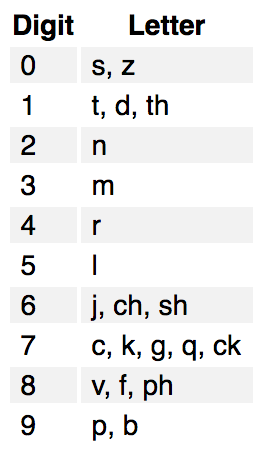The mnemonic major system is quite ancient. In its most pure form, each number is a letter and letters form words that can be easily remembered.
Ancient alphabets and new champions
When we consider the Hebrew alphabet, each letter is a number, and Kabbalah is using this to achieve miraculous deeds. In Hindu there is a similar tradition called the Katapayadi system, which was used to encode geometrical and astronomical data in poetical verses. In western tradition the major mnemonic system was introduced by Puritan reformers in the 16th century as a more pure way to remember things.
Dominic O’Brien used this methodology with memory palaces to develop his own Dominic technique and win 8 world memory championships. I do not claim to be a master of this method, but I do use it when faced with overwhelming odds.
Dictionaries
At the core of the Major System are dictionaries. We encode one dictionary (such as numbers) using another, easier dictionary (like letters). This technique can be applied with different dictionaries to achieve a similar effect. When learning something complex and difficult to remember, a dictionary can be helpful.
The first time I used this method was when learning chemistry. Initially, I used simple imagery for several elements and became adept at combining them. However, when I needed to remember a complex chemical process in the semiconductor industry, I lacked sufficient images. To tackle this, I developed a dictionary for the entire periodic table, including symbols for parentheses and the numbers 0-9, which allowed me to remember any chemical composition. Later, I used a similar method to remember combinations of letters and numbers, such as passwords and abstract information. As long as you maintain a 1:1 correspondence between the difficult material and something easily memorable, you can effectively retain the information.
FAQ
- How do you memorize THAT? From time to time I am faced with memorization tasks that the best way to memorize them is by using a dictionary. For example, a couple of months ago a student asked me how to organize shirts by color. I used a very simple dictionary green=grass, yellow=sun, black=ground etc and he remembered 20 colored shirts in no time. If a task seems very complex, but also very repetitive, major system will help.
- Do we need spaced repetitions? When performing research on spaced repetitions, scientists always generate information that cannot be easily remembered. To trick the system, magicians occasionally learn major system for phonetic sequences and show supernatural skills. There is some preservation of effort: first, you need to invest a lot of effort learning a dictionary, but hen you save a lot of effort using it.
- How do we explain this to a child? Some variations of major system [like using the first letter in each word] provide a delightful and easily explainable method. You can easily teach a child some funny verse, when the verse, in fact, encodes an order of planets, chemical structure, physical constant or some code. The effort is invested by the creator of the mnemonics, for users of the mnemonics, the process is almost effortless.
- So common and yet so elusive! Rare stuff forces us to strain our minds, to create special and specific markers. However, when we see something as generic as a common name it is easy to misplace it. Dictionaries help. Every name, every definition has its etymology, and something there should be useful for a marker, and you can use it as a dictionary entry.
- Synaesthesia. One of the added values of synaesthesia is replacing one set of dictionaries by another: music by letters, feelings by colors and so on. In this sense, synaesthesia is closely related to Major System. By learning synaesthesia, coding becomes automatic. Every programmer knows that working with code highlighter REALLY helps.
Have it YOUR way
While we usually learn Major Mnemonic system to remember numbers, it can, in fact, be used to remember ANY dictionary. If something is too abstract or unremarkable or elusive that you cannot remember it, consider adding it as an entry to your dictionary.
You are welcome to read more here.

Get 4 Free Sample Chapters of the Key To Study Book
Get access to advanced training, and a selection of free apps to train your reading speed and visual memory


I’m taking the SL course – and now reading about Memory Palace system – and now I read about the Mnemonic image-digit dictionary approach. My question is: How to integrate the Memory Palace and SL marker system??
Please read http://www.keytostudy.com/memory-palaces/